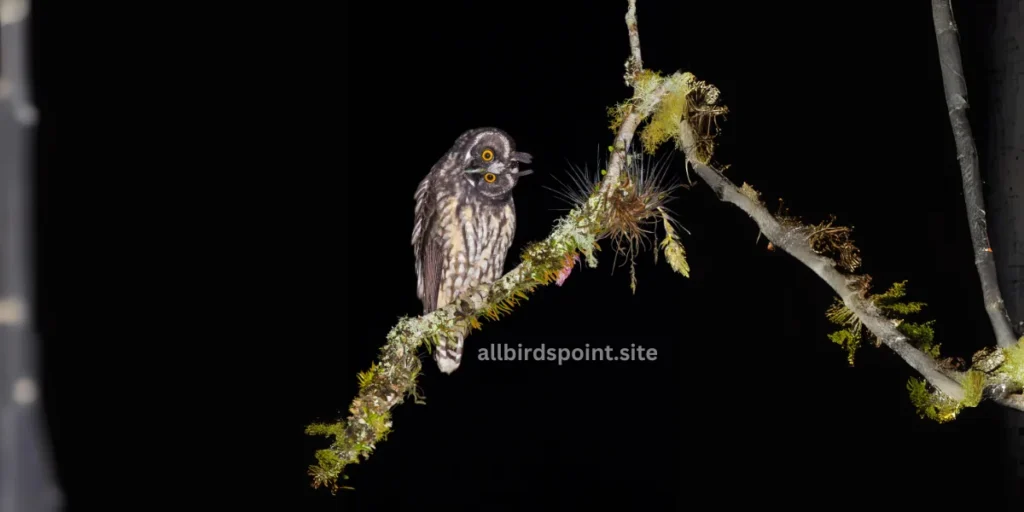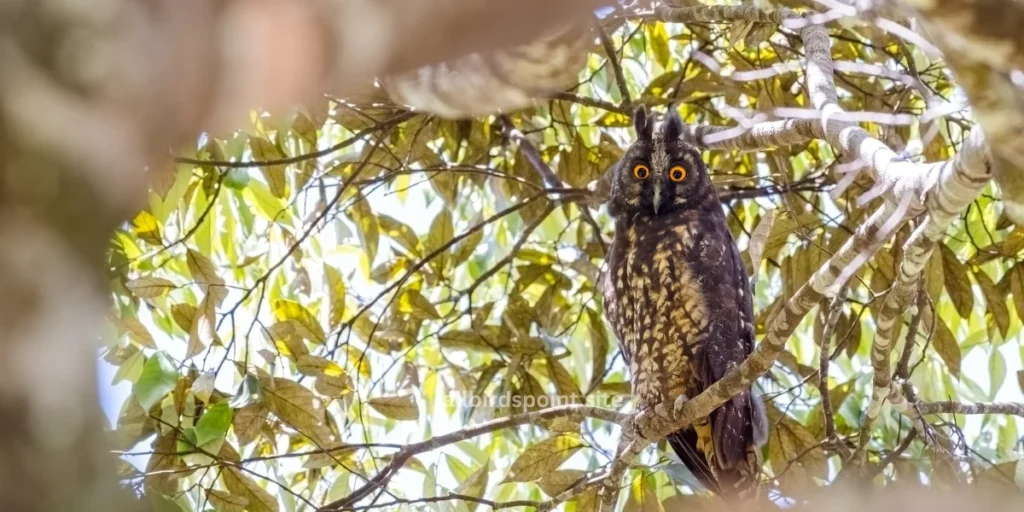Stygian Owl
The Stygian Owl is a bird that hunts at night. It eats small animals like mice and insects. This owl lives in forests, mainly in Central and South America. With dark feathers and big eyes, it blends well with its surroundings, making it hard to spot.
Stygian Owl: A Mysterious Night Hunter
The Stygian Owl (Asio stygius) is one of the most mysterious and intriguing owls found in nature. Known for its dark appearance and haunting calls, this bird of prey primarily resides in the forests and woodlands of Central and South America. In this comprehensive guide, we will explore everything you need to know about the Stygian Owl, from its habitat and behavior to its role in the ecosystem. The goal is to present this information in a simple and easy-to-understand way.
Overview of the Stygian Owl
The Stygian Owl is a nocturnal bird that belongs to the family Strigidae, which includes true owls. Its name “Stygian” comes from Greek mythology, meaning dark or shadowy, a fitting name for this owl due to its dark plumage and mysterious nature. The Stygian Owl is known for its ability to blend into the night, making it difficult to spot.
This owl is not as well-known as other owl species, which adds to its enigmatic reputation. It is a solitary bird, often found alone or in pairs. Despite its secretive nature, the Stygian Owl plays an important role in the ecosystems where it lives, primarily by controlling populations of small animals like rodents and insects.

Physical Characteristics
The Stygian Owl has several physical features that help it survive in the wild. These features not only give it a unique appearance but also enable it to be an effective hunter.
| Feature | Description |
|---|---|
| Size | Medium-sized owl, with a body length of 38-46 cm. |
| Wingspan | Its wingspan ranges between 90-100 cm. |
| Feathers | Dark brown to black feathers, making it blend into the night. |
| Eyes | Large, deep-set, yellow eyes that are excellent for night vision. |
| Ears | Prominent ear tufts, although they are not used for hearing. |
| Beak and Claws | Strong, hooked beak and sharp claws for catching prey. |
Habitat and Distribution
The Stygian Owl prefers dense forests and woodlands, although it can also be found in more open areas such as savannas and grasslands. This owl thrives in environments where there are plenty of trees for cover, as it uses these trees both for nesting and for hunting.
Distribution by Region
| Region | Countries |
|---|---|
| Central America | Mexico, Belize, Honduras, Nicaragua |
| South America | Brazil, Argentina, Colombia, Venezuela |
| Caribbean | Cuba, Dominican Republic, Puerto Rico |
Preferred Habitat
- Dense forests: The Stygian Owl mainly lives in areas with thick tree cover.
- Mountains: Sometimes, it can be found in mountainous regions with high elevation.
- Savannas and Grasslands: Though less common, it may occasionally inhabit open landscapes with scattered trees.

Diet and Hunting Behavior
The Stygian Owl is a carnivorous bird, meaning its diet consists mainly of meat. It is a nocturnal hunter, which means it is most active during the night. Its excellent night vision and sharp hearing make it a skilled predator.
What Does the Stygian Owl Eat?
| Prey Type | Description |
|---|---|
| Rodents | Mice, rats, and other small mammals form the bulk of its diet. |
| Insects | Large insects such as beetles and grasshoppers. |
| Birds | Occasionally, it may hunt small birds. |
| Reptiles | Small lizards and snakes may also be preyed upon. |
The Stygian Owl uses its silent flight to sneak up on its prey. Once close enough, it swoops down and catches its target with its sharp talons. It then uses its strong beak to kill and eat the prey. This owl usually hunts from a perch, watching the ground for movement before making its move.
Reproduction and Life Cycle
Like many other owl species, the Stygian Owl has a fairly simple life cycle. It is monogamous, meaning that it mates with one partner for life. The breeding season for these owls varies depending on their location, but it usually takes place between January and June.
Nesting and Eggs
- Nesting Location: The Stygian Owl builds its nest in tall trees or uses old nests made by other large birds.
- Eggs: The female usually lays 1 to 2 eggs per clutch.
- Incubation: The eggs are incubated by the female for about 30 days, while the male brings food to her during this period.
- Chick Development: Once the chicks hatch, both parents take care of them until they are strong enough to leave the nest. The young owls can fly within 4 to 5 weeks after hatching but stay with their parents for several more months.
The Role of the Stygian Owl in the Ecosystem
The Stygian Owl plays an essential role in maintaining the balance of nature in its habitat. As a top predator, it helps to keep the populations of small animals like rodents and insects in check. Without predators like the Stygian Owl, these populations could grow out of control, leading to various environmental problems.
Benefits to the Ecosystem:
- Rodent Control: By feeding on mice and rats, the owl helps prevent these animals from damaging crops and spreading disease.
- Insect Population Management: Large insects can sometimes become pests, so the owl helps keep their numbers in balance.
Threats and Conservation Status
Like many wildlife species, the Stygian Owl faces several threats in the wild. Habitat loss due to deforestation is one of the biggest challenges for this owl, as it depends on large areas of forest for survival. Additionally, human activities such as agriculture and urban development are encroaching on the owl’s habitat, making it harder for them to find food and safe nesting sites.

Conservation Status
According to the International Union for Conservation of Nature (IUCN), the Stygian Owl is listed as a species of “Least Concern.” This means that its population is currently stable. However, the loss of habitat and environmental changes could pose a future threat to its survival.
Main Threats:
- Deforestation: Loss of trees reduces nesting and hunting areas for the owl.
- Human Encroachment: Expanding cities and farmlands shrink the owl’s natural habitat.
- Climate Change: Changes in temperature and weather patterns may disrupt food availability.
Interesting Facts about the Stygian Owl
Here are some fascinating facts about the Stygian Owl that highlight its unique qualities:
- Silent Flight: The Stygian Owl has special feathers that allow it to fly without making noise, helping it sneak up on its prey.
- Sharp Hearing: This owl has incredible hearing, which helps it locate prey even in complete darkness.
- Rare Sightings: Because of its secretive nature and preference for dense forests, the Stygian Owl is rarely seen by humans.
- Mythology Connection: The name “Stygian” comes from Greek mythology, referring to the River Styx, which is connected to the underworld. This name highlights the owl’s dark and mysterious aura.
Conclusion
The Stygian Owl is a fascinating and mysterious bird that plays an important role in the ecosystems where it lives. With its dark feathers, sharp eyes, and impressive hunting skills, this owl is perfectly adapted to life in the shadows of the night. While it is not currently endangered, protecting its habitat will be key to ensuring its survival in the future.
This owl, with its quiet grace and effective hunting techniques, serves as a reminder of the delicate balance of nature and the importance of preserving the forests and woodlands that it calls home.
FAQs
1. What is a Stygian Owl?
The Stygian Owl is a nocturnal bird of prey found in forests of Central and South America, known for its dark feathers and haunting calls.
2. What does the Stygian Owl eat?
The Stygian Owl primarily eats small mammals like rodents, insects, and occasionally birds or reptiles.
3. Where does the Stygian Owl live?
The Stygian Owl lives in dense forests, woodlands, and sometimes savannas in Central and South America.
4. Is the Stygian Owl endangered?
Currently, the Stygian Owl is listed as “Least Concern,” meaning its population is stable, but deforestation poses a future threat.
5. Why is it called the Stygian Owl?
The name “Stygian” comes from Greek mythology and refers to something dark or shadowy, fitting the owl’s appearance.

f0g6vi